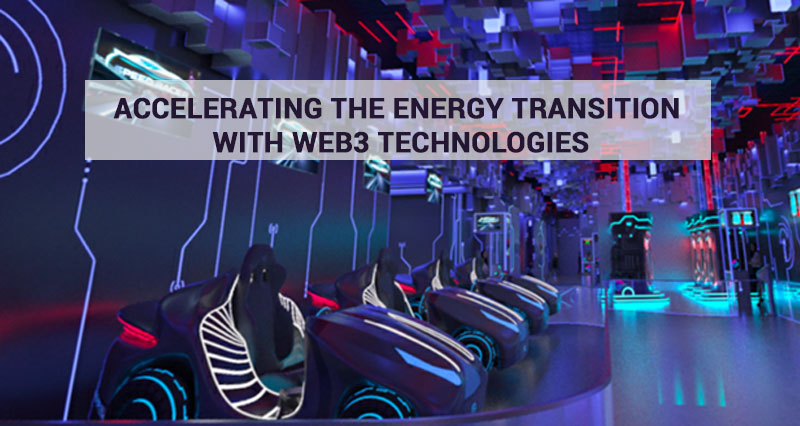Our world is at a critical moment in combating climate change and switching to more sustainable energy sources. There has never been a more pressing need to cut back on greenhouse gas emissions and lessen the effects of global warming.
Emerging technologies are fundamentally changing the energy landscape at this critical juncture. One of these technologies, Web3, the newest iteration of the internet, can potentially push the energy transition along more quickly than ever.
This blog aims to explore how Web3 technologies promote a greener, more effective, and decentralized energy environment. We will examine how Web3 technologies are driving a new era of sustainable energy, from blockchain-enabled energy business to the Internet of Things (IoT) devices on a distributed network, but first, let’s learn more about Web3.
What Web3 is All About?
The term “Web3” is used to refer to the upcoming internet revolution. It implies the development of decentralized technology, which has made it possible for a network to be more distributed. Web3 technologies are open-source, decentralized, and interoperable. These developments span a number of industries, including web3 game development services, where the concepts of open collaboration and decentralization are transforming the gaming business.
Blockchain, AI, big data analytics, and computer-generated images are some of them. In industries like health, banking, and energy, where decentralized networks may be utilized to lower costs and boost security, these technologies are driving expansion.
How is Web3 Accelerating the Energy Transition?
Web3 is playing a crucial role in accelerating the energy transition. With its advanced technologies and capabilities, Web3 enables the development of innovative technology solutions in the energy sector. Here are some of the ways Web3 is boosting energy sustainability.
Page of Contents
Smart Contracts for Trading Energy
Smart contracts, self-executing contracts with the terms encoded straight into code, are introduced by Web3 technologies. By automating energy business, these smart contracts can ensure that all energy transactions are safe, open, and tamper-proof.
Smart contracts can automatically sell extra energy produced by solar panel owners to the grid or to nearby consumers, assuring fair compensation without the need for middlemen. For the energy industry, this degree of automation and transparency is revolutionary.
Grids for Decentralized Energy
Traditional energy grids are less dependable and less equipped to accommodate renewable energy sources since they are centralized and susceptible to disturbances. Decentralized energy grids can be built using Web3 technologies, particularly blockchain. With blockchain, energy providers and customers may communicate directly, cutting out middlemen and enabling peer-to-peer energy trading.
This implies that excess solar energy produced on a homeowner’s roof can be sold directly to neighbors who are in need. It not only encourages the use of sustainable energy but also develops new sources of income for both individuals and companies.
Asset Tokenization for Energy
Energy assets can be tokenized thanks to Web3 technologies. The ownership of renewable energy projects like wind farms and solar panels can be represented via tokens. The potential to buy and sell these tokens on blockchain-based marketplaces makes investing in renewable energy projects simpler for people and investors.
More people are encouraged to support and profit from renewable energy sources as a result of the democratization of access to clean energy investments.
Data-Driven Efficiency and IoT
Internet of Things (IoT) devices are now increasingly used in the energy sector. These gadgets gather real-time information about energy distribution, production, and consumption.
Blockchain technology can be used in a Web3 ecosystem to safely and openly distribute this data. With less downtime and greater total energy infrastructure efficiency, this optimizes energy use and enables predictive maintenance.
Community-Based Energy Projects
Web3 technologies allow communities to take charge of their future energy needs. Using decentralized governance models made possible by blockchain, communities can decide on their energy infrastructure.
They can allocate energy resources, set criteria for energy efficiency, and fund and manage renewable energy initiatives. This encourages a sense of accountability and ownership among community members, resulting in more robust and sustainable energy systems.
Carbon Credits and Energy Traceability
Tracking the energy source and its carbon footprint is a perfect application for blockchain technology. Every energy unit has a source that can be identified, ensuring consumers know how their energy use affects the environment.
The growth of carbon credit markets, where both people and businesses alike can buy and sell carbon credits to offset their emissions, depends on this transparency. Web3 technologies make creating and trading these credits easier, encouraging the use and production of cleaner energy.
Final Thoughts
Shifting to cleaner energy is a prominent challenge today. However, Web3 technology can facilitate this transition by enabling direct energy trading, utilizing smart contracts for energy deals, and promoting the adoption of renewable energy sources. Individuals, communities, and businesses gain greater control over energy choices by integrating IoT, blockchain, and community decision-making.
This empowerment contributes to a more environmentally friendly approach, reducing carbon footprint. As Web3 technology continues to improve, its role in enhancing the cleanliness and efficiency of global energy systems will become increasingly prominent.
